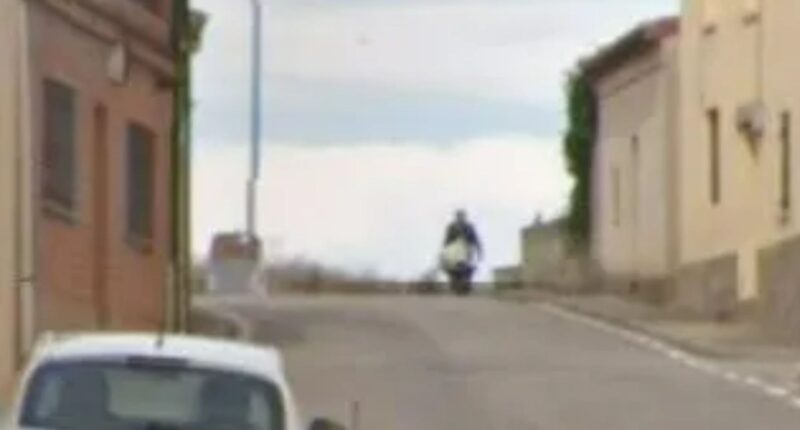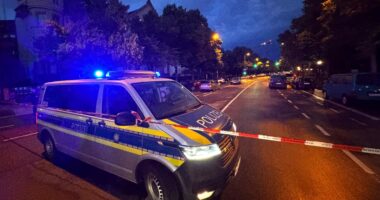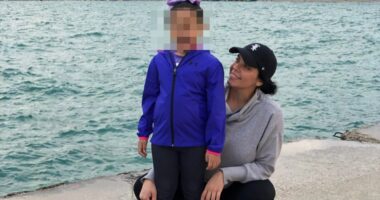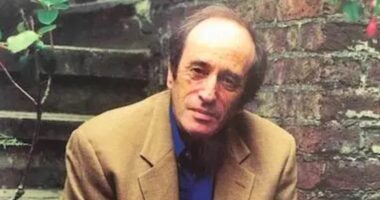A DISTURBING Google Street View image appears to show a dead body being moved in a wheelbarrow – before cops discovered human remains.
A series of photographs captured in a small Spanish village have potentially played a crucial role in helping authorities solve a murder case involving a love triangle. The images revealed a man appearing to stuff what observers believed to be a lifeless body into the trunk of a red vehicle.



He is seen stuffing a body-shaped package, wrapped in white plastic, into the boot on a deserted road.
Furthermore, an additional eerie picture has surfaced, showing an individual donning similar attire on a hill close by, seemingly handling a wheelbarrow – a possible method of moving the body to the car.
Spanish police said the first car picture was one of the clues they worked with to “resolve the crime” after a missing husband vanished last year.
He is believed to have been killed and dismembered after disappearing.
The body of the unnamed Cuban victim, only referred to by the initials JLPO, was found in a nearby cemetery last week.
Police then revealed they had been helped by Google Street View when the pictures led them to focus on the victim’s wife and her new partner.
Wiretaps later revealed their alleged involvement in JLPO’s sudden disappearance.
The couple were arrested on suspicion of murder.
Central government officials said they believe the human torso found belongs to that of a 33-year-old Cuban man who went missing last November.
According to local sources, the victim met his tragic fate after traveling to Spain and learning that his Cuban spouse was engaging in infidelity with another man, now one of the individuals detained in connection with the crime.
The male suspect is a Spanish bar owner apparently nicknamed ‘The Wolf of Tayueco’ after the small village of just 56 inhabitants.
It is just a 15-minute drive from the cemetery where the remains were found.
In their first comments about the investigation and arrests overnight, a spokesman for Spain’s National Police said: “National Police officers have detained two people allegedly involved in the disappearance and death of a man who was reported missing in November last year by a relative.
“That relative had grown suspicious about messages he had received purporting to be from the missing man.
“Part of the victim’s remains have been found buried in a cemetery in Andaluz in Soria using ‘advanced techniques.’
“One of the clues investigators were working with were images from an online search location application.”
The force added in a statement: “The messages the missing man’s family received said he met a girl and was leaving Soria and getting rid of his telephone.
“This made the relative suspect someone else was sending the messages and that led to him alerting police.
“The police investigation focused on the missing man’s closest circle and led to the arrest of the two suspects believed to be responsible for his disappearance on November 12.
“They were the missing man’s partner and a man who had been her partner.
“They were initially held on suspicion of unlawful detention for failing to explain his disappearance.
“Searches of the pair’s homes and vehicles were subsequently authorised by police, where evidence relevant to the investigation was uncovered.”
The force also said that the image “was an additional piece of evidence” and that “both suspects have been remanded in prison by an investigating judge”.
The spokesperson added : “The discovery of human remains buried underground in the cemetery in the province of Soria occurred on December 11 after they were sent to jail.
“Those remains have yet to be fully identified by coroners but we believe they correspond to those of the missing man.
“The investigation is ongoing.”
This isn’t the first time criminal activity has been caught through Google Maps.
Italian mafia fugitive Gioacchino Gammino was caught after 20 years on the run with the help of the online scanner.
Italian police had a breakthrough when they came across an image showing an elderly man outside a grocery shop in the town of Galapagar north of Madrid.
Gammino, 60, had changed his name to Manuel after escaping a prison in Rome in 2002.




















